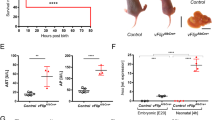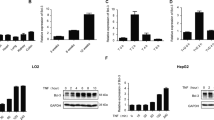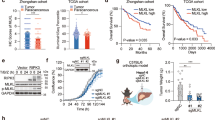Abstract
Dysregulation of apoptosis contributes to the pathogenesis of many human diseases. As effectors of the apoptotic machinery, caspases are considered potential therapeutic targets. Using an established in vivo model of Fas-mediated apoptosis, we demonstrate here that elimination of certain caspases was compensated in vivo by the activation of other caspases. Hepatocyte apoptosis and mouse death induced by the Fas agonistic antibody Jo2 required proapoptotic Bcl-2 family member Bid and used a Bid-mediated mitochondrial pathway of caspase activation; deficiency in caspases essential for this pathway, caspase-9 or caspase-3, unexpectedly resulted in rapid activation of alternate caspases after injection of Jo2, and therefore failed to protect mice against Jo2 toxicity. Moreover, both ultraviolet and gamma irradiation, two established inducers of the mitochondrial caspase-activation pathway, also elicited compensatory activation of caspases in cultured caspase-3−/− hepatocytes, indicating that the compensatory caspase activation was mediated through the mitochondria. Our findings provide direct experimental evidence for compensatory pathways of caspase activation. This issue should therefore be considered in developing caspase inhibitors for therapeutic applications.
This is a preview of subscription content, access via your institution
Access options
Subscribe to this journal
Receive 12 print issues and online access
$209.00 per year
only $17.42 per issue
Buy this article
- Purchase on Springer Link
- Instant access to full article PDF
Prices may be subject to local taxes which are calculated during checkout






Similar content being viewed by others
References
Vaux, D.L. & Korsmeyer, S.J. Cell death in development. Cell 96, 245–254 (1999).
Thompson, C.B. Apoptosis in the pathogenesis and treatment of disease. Science 267, 1455–1462 (1995).
Thornberry, N.A. & Lazebnik, Y. Caspases: Enemies within. Science 281, 1312–1316 (1998).
Zheng, T.S. & Flavell, R.A. Divinations and surprises: Genetic analysis of caspase function in mice. Exp. Cell Res. 256, 67–73 (2000)
Luo, X., Budihardjo, I., Zou, H., Slaughter, C. & Wang, X. Bid, a Bcl2 interacting protein, mediates cytochrome c release from mitochondria in response to activation of cell surface death receptors. Cell 84, 481–490 (1998).
Li, H., Zhu, H., Xu, C.-J. & Yuan, J. Cleavage of BID by caspase 8 mediates the mitochondrial damage in the Fas pathway of apoptosis. Cell 94, 491–501 (1998).
Kuida, K. et al. Decreased apoptosis in the brain and premature lethality in CPP32-deficient mice. Nature 384, 368–372 (1996).
Kuida, K. et al. Reduced apoptosis and cytochrome c-mediated caspase activation in mice lacking caspase 9. Cell 94, 325–337 (1998).
Hakem, R. et al. Differential requirement for caspase 9 in apoptotic pathways in vivo. Cell 94, 339–352. (1998).
Peter, M.E. & Krammer, P.H. Mechanisms of CD95 (APO-1/Fas)-mediated apoptosis. Curr. Opin. Immunol. 10, 545–551 (1998).
Scaffidi, C. et al. Two CD95 (APO-1/Fas) signaling pathways. EMBO J. 17, 1675–1684 (1998).
Yin, X.M. et al. Bid-deficient mice are resistant to Fas-induced hepatocellular apoptosis. Nature 400, 886–891 (1999).
Ogasawara, J. et al. Lethal effect of the anti-Fas antibody in mice. Nature 364, 806–809 (1993).
Rodriguez, I., Matsuura, K., Ody, C., Nagata, S. & Vassalli, P. Systemic injection of a tripeptide inhibits the intracellular activation of CPP32-like proteases in vivo and fully protects mice against Fas-mediated fulminant liver destruction and death. J. Exp. Med. 184, 2067–2072 (1996).
Lacronique, V. et al. Bcl-2 protects from lethal hepatic apoptosis induced by an anti-Fas antibody in mice. Nature Med. 2, 80–85 (1996).
Zheng, T.S. et al., Caspase-3 controls both cytoplasmic and nuclear events associated with Fas-mediated apoptosis in vivo. Proc. Natl. Acad. Sci. USA 95, 13618–136238 (1998).
Slee, E.A. et al. Ordering the cytochrome c-initiated caspase cascade: Hierarchical activation of caspase-2, -3, -6, -7, -8, and -10 in a caspase-9-dependent manner. J. Cell Biol. 144, 281–292 (1999).
Yang, J. et al. Prevention of apoptosis by Bcl-2: release of cytochrome c from mitochondria blocked. Science 275, 1129–1132 (1997).
Kluck, R.M., Bossy-Wetzel, E., Green, D.R. & Newmeyer, D.D. The release of cytochrome c from mitochondria: a primary site for Bcl-2 regulation of apoptosis. Science 275, 1132–1136 (1997)
Srinivasan, A. et al. In situ immunodetection of activated caspase-3 in apoptotic neurons in the developing nervous system. Cell Death Differ. 5, 1004–1016 (1998).
Y. Kouroku et al. Detection of activated Caspase-3 by a cleavage site-directed antiserum during naturally occurring DRG neurons apoptosis. Biochem. Biophys. Res. Comm. 247, 780–784 (1998).
Woo, M. et al. Essential contribution of caspase-3/CPP32 to apoptosis and it associated nuclear changes. Genes Dev. 12, 806–819 (1998).
Janicke, R.U., Sprengart, M.L., Wati, M.R. & Porter, A.G. Caspase-3 is required for DNA fragmentation and morphological changes associated with apoptosis. J. Biol. Chem. 273, 9357–9360 (1998)
Thornberry, N. A. et al. A combinatorial approach defines specificities of members of the caspase family and granzyme B. Functional relationships established for key mediators of apoptosis. J. Biol. Chem. 272, 17907–17911 (1997).
Hofmann, K., Bucher, P. & Tshopp, J. The CARD domain: a new apoptotic signaling motif. Trends Biochem. Sci. 22, 155–156 (1997).
Hummler, E. et al. Targeted mutation of the CREB gene: compensation within the CREB/ATF family of transcription factors. Proc. Natl. Acad. Sci. USA 91, 5647–5651 (1994).
Huang, D.C. et al. Activation of Fas by FasL induces apoptosis by a mechanism that cannot be blocked by Bcl-2 or Bcl-xL. Proc. Natl. Acad. Sci. USA 96, 14871–14876 (1999).
Chandler, J.M., Cohen, G.M. & MacFarlane, M. Different subcellular distribution of caspase-3 and caspase-7 following Fas-induced apoptosis in mouse liver. J. Biol. Chem. 273, 10815–10818 (1998).
Woo, M. et al. In vivo evidence that caspase-3 is required for Fas-mediated apoptosis of hepatocytes. J. Immunol. 163, 4909–4916 (1999).
Susin, S.A. et al. Mitochondrial release of caspase-2 and -9 during the apoptotic process. J. Exp. Med. 189, 381–394 (1999).
Yoshida, H. et al. Apaf1 is required for mitochondrial pathways of apoptosis and brain development. Cell 94, 739–750 (1998).
Acknowledgements
We thank L. Evangelisti, C. Hughes and D. Butkus for embryonic stem cell culture and injection, K. Augustyn for primary hepatocyte isolation and F. Manzo for help in preparing this manuscript. This work was supported in part by National Institutes of Health grant 1 P30 DK34989 (T.S.Z.). S.H. is a recipient of the Lavoisier Program Fellowship (France) and is also supported by a fellowship from the Parkinson's Disease Foundation (New York, New York). Y.L. is partly supported by National Institutes of Health grant CA 13106-25. R.A.F. is an Investigator of the Howard Hughes Medical Institute.
Author information
Authors and Affiliations
Corresponding author
Rights and permissions
About this article
Cite this article
Zheng, T., Hunot, S., Kuida, K. et al. Deficiency in caspase-9 or caspase-3 induces compensatory caspase activation. Nat Med 6, 1241–1247 (2000). https://doi.org/10.1038/81343
Received:
Accepted:
Issue Date:
DOI: https://doi.org/10.1038/81343
This article is cited by
-
A Review on Caspases: Key Regulators of Biological Activities and Apoptosis
Molecular Neurobiology (2023)
-
Knockout of caspase-7 gene improves the expression of recombinant protein in CHO cell line through the cell cycle arrest in G2/M phase
Biological Research (2022)
-
Trichosanthin cooperates with Granzyme B to restrain tumor formation in tongue squamous cell carcinoma
BMC Complementary Medicine and Therapies (2021)
-
AIM2 forms a complex with pyrin and ZBP1 to drive PANoptosis and host defence
Nature (2021)
-
In vitro evaluation of the anticancer activity of barbituric/thiobarbituric acid-based chromene derivatives
Molecular Biology Reports (2021)



